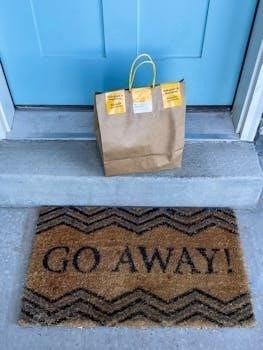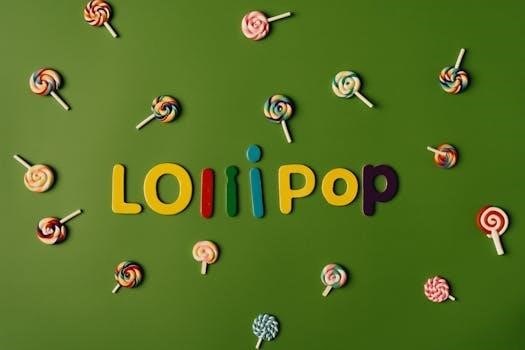Pop to the Shops Instructions Article Plan
This comprehensive guide delves into the delightful “Pop to the Shops” board game! We will explore everything from setting up the game and understanding its objective, to navigating player turns, and moving around the game board, all while incorporating strategic shopping adventures for the players․
Game Setup
To begin your “Pop to the Shops” adventure, carefully assemble the game board in the center of the playing area, ensuring all sections are properly connected․ Next, populate the designated spaces within each shop on the board with the corresponding yellow-backed cards․ These cards typically represent the various items available for purchase in each establishment․
Separately, shuffle the white grocery cards and place them face down in a designated area, forming the draw pile for players’ shopping lists․ Each player then selects a character and places it on the starting space․ Provide each player with a shopping bag board to keep track of their purchases and a starting amount of play money․
Distribute the play money evenly amongst the players, ensuring each has an equal starting fund․ Finally, ensure you have easy access to all components such as the dice, item cards and character stands․ Reviewing the rules briefly before starting can prevent confusion later․ You’re now ready to embark on your shopping spree!
Objective of the Game

The primary objective of “Pop to the Shops” is to be the first player to successfully purchase all the items on your shopping list and return to the starting point․ Each player begins the game with a unique shopping list, typically consisting of a set of randomly selected items represented by item cards or tokens․ The shopping list dictates which shops players must visit and what goods they need to acquire․
Players must strategically navigate the game board, moving from shop to shop, using play money to purchase their desired items․ The challenge lies in efficiently managing your funds, making correct change, and planning your route to minimize travel time․ The game encourages basic math skills and financial literacy as players learn to handle money and make purchasing decisions․
The first player to collect all the items on their shopping list and return to the designated starting space is declared the winner, showcasing their shopping prowess and strategic planning․
Player Turns
On each player’s turn in “Pop to the Shops,” they typically perform a sequence of actions to progress towards completing their shopping list․ The turn usually begins with rolling a die or spinner to determine how many spaces the player can move their character around the game board․ Movement is generally along a predefined path connecting the various shops․
After moving, if the player lands on a shop that contains an item on their shopping list, they have the opportunity to purchase that item․ This involves paying the required amount using their play money․ Successfully purchasing an item means acquiring the corresponding item card or token and marking it off their shopping list․
If a player lands on a space that doesn’t have a needed item, their turn typically ends after movement․ Some versions of the game might include special spaces that trigger events or challenges, adding an element of surprise and strategy․ Once the player has completed these actions, the turn passes to the next player in a clockwise or predefined order․
Moving Around the Board
Movement in “Pop to the Shops” is a crucial aspect of the game, dictating how players navigate the board to reach the various shops and acquire their desired items․ Typically, players roll a die or spin a spinner at the start of their turn to determine the number of spaces they can move their character․
The game board usually features a circular or linear path connecting the different shops․ Players move their character along this path, counting each space as they progress․ Some spaces might have special instructions or effects, such as requiring the player to skip a turn or draw a card․ Strategic movement is important, as players need to plan their route to efficiently visit the shops containing the items on their shopping list․
The game board might also incorporate shortcuts or obstacles that can impact movement․ Successfully navigating the board and landing on the right shops is key to completing the shopping list and winning the game․
Shopping for Items
The core of “Pop to the Shops” revolves around the act of shopping itself․ Once a player lands their character on a shop, they can attempt to purchase an item from that shop․ The availability of items is often represented by cards or tokens placed within each shop’s designated area on the game board․
To purchase an item, the player must typically have the corresponding item on their shopping list․ If the item is available and matches an item the player needs, they can proceed with the purchase using the game’s play money․ The item card or token is then added to the player’s shopping bag or basket, indicating that they have successfully acquired it․
However, if the desired item is not available in the shop (perhaps another player already bought it), the player must wait until their next turn to attempt the purchase again․ Strategic shopping is essential, as players must prioritize their purchases and adapt to the changing availability of items in each shop․
Using Play Money
Play money is a fundamental component of “Pop to the Shops,” simulating real-world financial transactions․ Each player starts with a designated amount of play money, often in a mix of different denominations․ This money is used to purchase items from the various shops on the game board, as indicated on the item cards or tokens․
When a player wishes to buy an item, they must pay the price shown on the item card or token․ This involves counting out the correct amount of play money and handing it over to the “shopkeeper,” which is usually another player or a designated area on the board․

The game encourages players to practice their addition and subtraction skills as they manage their money and make purchases․ The denominations of the play money are designed to reflect real-world currency, helping children understand the value of different bills and coins․ Efficient money management is key to successfully completing your shopping list and winning the game․
Handling Change
An essential part of “Pop to the Shops” involves accurately handling change․ It is extremely common that when buying an item, players may not have the exact amount of play money required․ In such cases, they must pay with a larger denomination and receive the correct change back from the shopkeeper․
The shopkeeper, whether another player or a designated area on the board, is responsible for calculating and providing the correct change․ This involves subtracting the item’s price from the amount tendered by the player․ The change should be given in a combination of play money that is easy to manage and count․
Properly handling change reinforces subtraction skills and promotes a deeper understanding of money management․ Players learn to anticipate the amount of change they should receive and to verify its accuracy․ Dealing with change scenarios adds a layer of complexity to the game, making it more realistic and educationally beneficial․ Mastering this skill is crucial for efficient shopping within the game and ultimately for securing victory․
Winning the Game
The ultimate goal in “Pop to the Shops” is to be the first player to successfully complete their shopping list․ This involves strategically navigating the game board, visiting the appropriate shops, purchasing all the required items, and returning to the designated finish point, often the starting location or a central hub on the board․

A player is declared the winner once they have acquired all items on their shopping list and have made their way back to the designated finish․ Successful completion requires a combination of skillful movement around the board, efficient money management, and perhaps a little bit of luck with the dice rolls or card draws․
The game encourages strategic planning, as players must decide the most efficient route to collect their items․ It is also a test of their ability to adapt, as unexpected events or the actions of other players can disrupt their plans․ Therefore, the winner is not only lucky but also demonstrates resourcefulness and good decision-making throughout the game․

Variations and House Rules
“Pop to the Shops” is a game that lends itself well to variations and house rules, allowing players to customize the experience to suit their preferences and skill levels․ Some popular variations involve modifying the shopping lists, altering the movement rules, or introducing new challenges and events to the game․
One common variation is to adjust the difficulty by changing the number of items on the shopping list․ For younger players, reducing the number of items simplifies the game, while adding more items increases the complexity for older or more experienced players․
Another variation involves altering the movement rules, such as allowing players to move diagonally or introducing shortcuts on the board․ House rules can also add new elements to the game, like “special event” cards that trigger unexpected events or challenges․ These variations inject new excitement and strategic depth into the gameplay․
Players can also modify the money system․ This could involve changing the starting amount of money or adjusting the prices of items in the shops․ By experimenting with these variations and house rules, players can create a unique and engaging gaming experience that caters to their specific needs and preferences․
Educational Benefits
“Pop to the Shops” offers a plethora of educational benefits, making it a valuable tool for learning while having fun․ The game naturally encourages the development of essential math skills․ Players handle play money, make purchases, and calculate change, reinforcing their understanding of addition, subtraction, and basic arithmetic․
Beyond math, the game also fosters crucial cognitive skills․ Players must plan their routes around the board, strategize their shopping trips, and remember which items they still need to purchase․ These activities enhance their problem-solving abilities, memory, and strategic thinking․
Moreover, “Pop to the Shops” promotes social interaction and communication skills․ Players take turns, negotiate, and learn to follow rules․ The game also presents opportunities to discuss budgeting, saving, and the value of money, instilling important financial literacy concepts․
In essence, this game transforms learning into an engaging experience․ It seamlessly integrates educational concepts into a playful context, making it an ideal tool for parents and educators seeking to cultivate math proficiency, cognitive development, and social skills in a fun and interactive way․ The game encourages children to learn about money handling․
